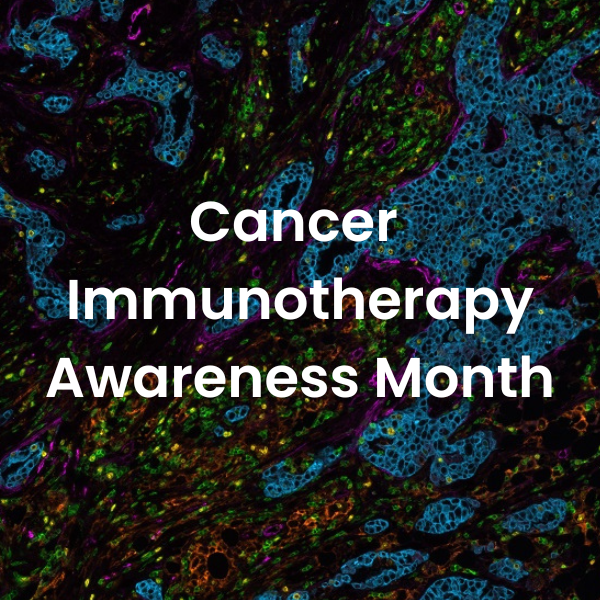Interview
Interview with Dr. Janis Taube: raising awareness about cancer immunotherapy
Posted on:

Immunotherapy is a growing area in cancer research, which aims to harness the body’s immune response against cancerous cells. In fact, immunotherapies are now some of the most promising treatments for cancer available today. But despite their success thus far—and despite ongoing efforts to improve them—there remains much about them that we do not understand: how they work, what determines their success rate in individual patients, and why some patients with the same tumor type respond differently than others under the same therapeutic approach.
The field of spatial biology is an exciting and fast-moving area. It has the potential to revolutionize immunotherapy by integrating knowledge obtained through multiplex immunofluorescence (mIF) and providing critical biological insights into cancer development and therapy response. Deepening our spatial biology understanding using mIF tools is essential for developing targeted immunotherapies; therefore, improved cancer treatments will result from increased adoption of spatial technologies.
To mark Cancer Immunotherapy Awareness Month, we sat down with Dr. Janis Taube to explore potential ways forward. Janis Taube, The George W. Hambrick, Jr. M.D. and Thomas G. Olsen, M.D. Professor of Dermatology division of Johns Hopkins Hospital in Baltimore, MD. She also serves as a Professor of Dermatology, Professor of Oncology, Professor of Pathology at the Johns Hopkins University School of Medicine, and a Scientific Advisory Board Member at Lunaphore. Dr. Taube is a world-leading expert who developed the PD-L1 immunohistochemical (IHC) assay and scoring system for the first-in-human anti-PD-1 and anti-PD-L1 clinical trials, versions of which are now FDA-approved and mainstays of cancer treatment. Her research primarily focuses on immune evasion by solid tumors—specifically studying the PD-1/PD-L1 axis—and identifying potential biomarkers that predict response to novel immunotherapies.
1. How did you get involved in biomarker research?
There were reports that cancers, including melanoma, expressed PD-L1 as a mechanism of immune evasion. When I first started my post-doctoral fellowship, I was curious to investigate at which phase of melanomagenesis PD-L1 became expressed. We gathered nevi, melanoma in situ, primary and metastatic melanomas to answer this question and developed an IHC assay for PD-L1. We found that PD-L1 expression was not related to the type or stage of melanocytic lesion but to the presence of an immune response. This led us to develop our PD-L1-mediated adaptive immune resistance hypothesis. We then tested this hypothesis by correlating PD-L1 expression within the tumor microenvironment (TME) with response to anti-PD-(L)1-based therapies.
2. The tumor microenvironment (TME) has an essential role in cancer progression. How can the field further harness the TME to accelerate the development of new therapeutic strategies?
A better understanding of components that lead to tumor progression, e.g., myeloid-derived suppressor cells or proteins that lead to immune exclusion in tumors, allows these different components to be targeted in a rational way, facilitating novel combinatorial therapeutic strategies. In addition, if a therapy is shown to be effective in one tumor type, it is possible to characterize the TME of other tumors to see if they show similar features and thus may also be likely to respond to the same regimen.
3. Why is spatial biology the new frontier for advancing our understanding of cancer immunology?
Tumors are well-organized ecosystems, and it is important to characterize this complexity with regard to the cells present as well as the spatial organization of those cells. Specifically, the immunologic component of the tumor is recognized to be a major mediator of tumor regression or progression and metastasis, and spatial biology can help researchers better understand how tumors interact with and potentially avoid the host immune response.
4. What are the current challenges in immunotherapy? How could these limiting factors be addressed by novel spatial biology techniques and through biomarker discovery?
Many immune checkpoints and their expression within the TME have been individually characterized. What is needed now is a better understanding of how these checkpoint molecules act in concert. Many novel spatial biology techniques facilitate this by visualizing numerous markers simultaneously in a single tissue specimen. In doing so, it will be possible to reveal checkpoints that may act in a co-dominant or subdominant way to therapeutically targeted checkpoints.
5. How are biomarkers dynamically expressed during cancer treatment?
Multiple mechanisms drive the expression of immune checkpoints within the TME. Chromosomal rearrangements in tumor cells drive some immune checkpoint expression, while others are expressed as a form of adaptive immune resistance. In the latter instance, the immune checkpoints are dynamically expressed on numerous cell types as they are exposed to interferon-gamma and other associated cytokines. In the case of adaptive PD-L1 expression in melanoma, patients whose tumors express PD-L1 on their cell surfaces paradoxically show improved survival compared to those who don’t, as it signifies an element of tumor control by a host immune response.
The dynamic expression of checkpoint markers is also particularly evident when comparing pre-and on-treatment tumor specimens. For example, pre-treatment tumor specimens from patients treated with anti-PD-1 inhibitors show a higher response rate to therapy when PD-L1 is expressed in their tumors. In the tumors that respond to therapy, PD-L1 expression is often further increased in their on-treatment specimens in response to the influx of T-cells and local IFN-gamma release.
6. When do you see spatial biomarkers in routine use in the clinic? And what are the most critical steps needed to achieve this goal?
Immune cell density metrics, co-expression profiling, and proximity assays are all under the umbrella of spatial biomarkers and, as such, imagine that spatial biomarkers will be implemented clinically in the next three to five years.
The first thing that needs to happen is that the ‘use case’ needs to be made about how much better these are than current biomarkers for predicting response to therapy, and that data is currently accumulating. After candidate biomarkers have been identified, proof of standardized outputs of these complex metrics across routine clinical labs will need to be demonstrated. Lastly, reimbursement from payers will be essential in establishing spatial biomarkers in clinical care.
Related Articles
Conversations with women in leadership – International Women’s Day 2023
Posted on 08 Mar 2023
Read Post
